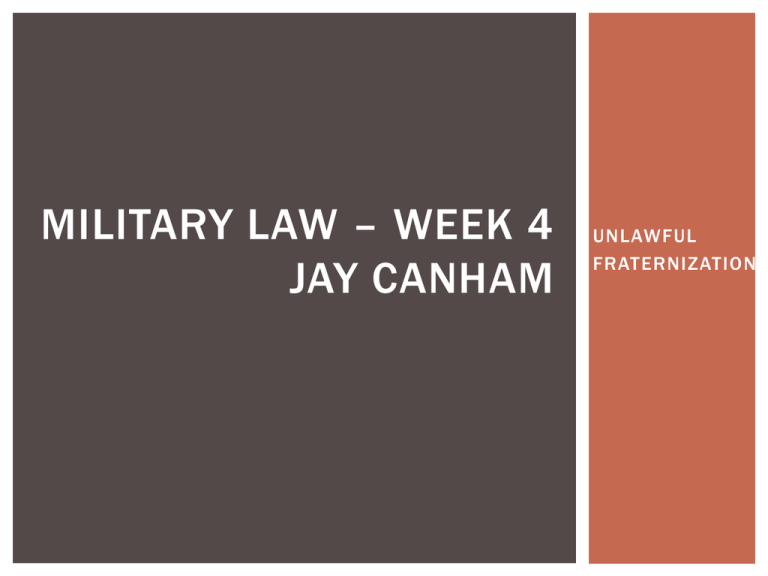
MILITARY LAW – WEEK 4
JAY CANHAM
UNLAWFUL
FRATERNIZATION
FRATERNIZATION
Any over-familiarity that erodes the seniorsubordinate relationship.
UNLAWFUL FRATERNIZATION
The crime of fraternization interferes with a unit’s
ability to accomplish the mission.
Unduly familiar relationships between seniors and
subordinates are:
Contrary to military custom
Do not respect the roles each party required to play
in obtaining mission accomplishment.
Call into question the ability of the senior to lead and
to make impartial decisions.
THE EFFECT FRATERNIZATION HAS ON A UNIT
Actual or apparent preferential treatment will destroy
a unit by:
Compromising the chain of command by an erosion
of respect for the senior leaders; and
By creating the appearance of favoritism, which in
turn destroys morale.
Hindering the ability of a leader to perform by
undermining his or her command authority and
calling into question a senior’s objectivity; and
By creating situations in combat that could result in
lives being placed at risk.
TRADITIONAL FRATERNIZATION:
OFFICER AND ENLISTED
“One-step” Method of Prosecution:
Need only prove the relationship exists. Said
relationship is presumed to be prejudicial to good
order and discipline.
Exception: Chief Petty Officer-Junior Enlisted
MODERN FRATERNIZATION
Officers and Officers or Enlisted and Enlisted.
“Two-step” Method of Prosecution:
1. Need to prove relationship existed; and
2. Need to prove an unduly familiar relationship is
actually prejudicial to good order and discipline.
DYNAMICS OF FRATERNIZATION
Gender neutral: Does not have to involve intimate
relationships between members of the opposite sex.
Junior Member’s Accountability. Traditionally, the
senior was the one held accountable. Under current
policies, the senior has primary responsibility for
deterring fraternization, but both parties are now
held accountable!
DYNAMICS OF FRATERNIZATION
Special Relationships. Commands have also defined
unlawful fraternization in regards to their own special
needs.
Staff/Instructor-Student Relationships.
Recruiters-Recruits/Applicants
Service Members who are Married
FRATERNIZATION
Prohibited Personal Relationships
Dating & Cohabitation & Intimate/sexual
relationships
Gambling
Prohibited business relationships
Loaning/borrowing money.
Business Partnerships
Commercial Solicitation
“PROPER OR LAWFUL” FRATERNIZATION
Community functions
Religious activities
Unit based social functions
“Right Arm Night”/ “Boss’s Night”
Athletic events
Routine, limited business transactions like:
Landlord/Tenant relationships
One-time transactions like the sale of a vehicle or
home .
CONSEQUENCES OF FRATERNIZATION
1. Counseling and/or an oral/written
reprimand; And/or
2. Order to cease improper relationship;
And/or
3. Reassignment and/or adverse evaluation
report; And/or
4. Non-judicial punishment (NJP) (Article 15,
UCMJ);
And/or
CONSEQUENCES OF FRATERNIZATION
5. Impose a bar to reenlistment; And/or
6. “Flagging” – puts a halt to all favorable personnel
actions for a Service-Member (i.e. promotion,
awards, and schooling).
7. Administrative Separation.
8. Courts-Martial
PROSECUTING FRATERNIZATION
A violation of Article 92 (Failure to Obey Order
or Regulation).
A violation of Article 134 (General Article –
Fraternization)
A violation of Article 133– Conduct
Unbecoming an Officer.
PROSECUTING FRATERNIZATION
Constitutional Challenges:
Recall the United
States Supreme Court opinion in Parker v. Levy, 417
U.S. 733 (1974), which recognized the military’s
special need for discipline, against which certain
personal liberties may pale.
Freedom of Association. This right is afforded less
weight because of the negative impact
fraternization has on discipline.
Vagueness. The existence of a long acknowledged
custom, and the circumstances surrounding the
misconduct, make the prohibition against
fraternization specific.
PROSECUTING FRATERNIZATION
Equal Protection. Officers have always been
held to a higher standard of conduct
Privacy. No right to privacy when it
compromises discipline.
SUMMATION
Unlawful fraternization is a viable
issue in today’s armed forces.
Unique among crimes in that the acts
alone are not wrongful per se, but
rather becomes a criminal offense
because of the circumstances under
which they are performed.
Fraternization is a significant
leadership challenge for the CO.
SUMMATION
A CO is tasked with developing
camaraderie and respect among the
ranks while maintaining good order
and discipline.
A balancing test of these competing
interests requires both a common
sense approach and positive
leadership to avoid problems caused
by unlawful fraternization .
SEXUAL HARRASSMENT
DEFINITION OF SEXUAL HARASSMENT
Sexual harassment is a form of sexual
discrimination that involves unwelcome
sexual advances, requests for sexual
favors, and other verbal or physical
conduct of a sexual nature.
IMPACT OF SEXUAL HARASSMENT ON A
MILITARY UNIT
If a member of a command is being sexually
harassed or pressured, it affects the ability of
that service member to perform as part of a
team.
This particular crime will impact unit
readiness and mission accomplishment.
SEXUAL HARASSMENT AND AGGRAVATING
CONDUCT IN THE MILITARY
1. Unlawful conduct as a condition of one’s job.
2. Unlawful conduct becomes a basis for career
or employment decisions.
Examples (1) and (2) above, are sometimes
referred to as “Quid pro quo.” This is a Latin
term meaning “this for that” and is understood
as a “trade.”
3. Unlawful conduct creates a hostile
environment
ESSENCE OF SEXUAL HARASSMENT
Inappropriate and unacceptable behavior in the
work environment and usually meets the
following criteria:
1. It must be unwelcome
2. Be sexual in nature
3. Occur or impact the work environment
CHARACTERISTICS OF SEXUAL HARASSMENT
Deliberate acts
Repeated
Involves a specific target
Will adversely impact on work productivity
ISSUES SURROUNDING SEXUAL
HARASSMENT
“Workplace”: An expansive term for military
members.
Continuous Conduct: Repetitive as opposed
to a single incident of poor judgment.
Non-gender specific: Women can victimize
men, and members of the same sex can
victimize each other.
ISSUES SURROUNDING SEXUAL
HARASSMENT
Peer Harassment: Not restricted to only
superiors harassing subordinates.
Reprisals: Services regulations strictly
prohibit reprisals against the victim.
False Complaints of Sexual Harassment:
Taking disciplinary action against individuals
who file false complaints.
GENERAL METHODS OF SEXUAL
HARASSMENT
Physical – Person is touched.
Verbal – Conversations containing sexual
innuendoes.
Nonverbal – Eye contact or gestures.
Environmental – Objects displayed in the
workplace.
EXAMPLES OF SEXUAL HARASSMENT
1. The display of sexual material which include sexist
cartoons, magazines or pictures;
2. Sexual jokes;
3. Comments on appearance of a sexual nature;
4. Threats;
5. Whistles or sexual gestures ranging from subtle
hints to direct propositions;
6. Repeated requests for dates;
7. Physical contact.
ENFORCING SEXUAL HARASSMENT
STANDARDS
Counseling
Verbal or written warning
Other methods …Transfer or Administrative
Processing
NJP or Courts-Martial
ARTICLE 93 OF THE UCMJ
Charge mandates:
1. That the victim be subject to the orders of
the accused
2. That the accused was cruel towards,
oppressed or maltreated that person
Article 93 was modified in 1984 to include
sexual harassment
OTHER ARTICLES USED IN PROSECUTING
SEXUAL HARRASSMENT
Bribery or Graft….under Article 134 under the UCMJ.
Dereliction of Duty….Article 92 of the UCMJ
Disrespect ….under Article 91 of the UCMJ.
Provoking Speech or Gestures….Article 117 of the
UCMJ
Extortion….under Article 127 under the UCMJ
Assault:
Articles 90, 91, or 128 for various assaults;
Article 120 for rape;
Article 125 for sodomy;
Article 134 for indecent acts or exposure;
Article 134 for indecent assaults and adultery.
PREVENTING SEXUAL HARASSMENT
CO/Supervisors/Leaders: Have both the obligation
and authority to prevent sexual harassment because
Service Regulations in regards to sexual harassment
can be summed up in three words:
zero tolerance policy.
Educate & Monitor
Establish an internal grievance procedure:
Take all complaints seriously
Promptly resolve complaints.
Appoint extensively trained people to receive
complaints.
Maintaining confidentiality to the extent possible .
ROLE OF THE VICTIM
IN THE HARASSMENT PROCESS
Under sexual harassment guidelines, the victim is
encouraged to inform the harasser. This is not a
requirement.
This guideline is also an attempt to resolve the situation
at the lowest level.
The next step is to bring the issue to the attention of the
supervisor. Some services impose deadlines on the
actual complaint in an effort to force timely reporting of
a serious crime.
Once the proper supervisor is advised of the problem, the
entire chain of command is put on “constructive” notice .
The supervisor has full authority and responsibility to
fully investigate the situation.
MILITARY LAW – WEEK 4
JAY CANHAM
UNLAWFUL
FRATERNIZATION





